
Components

- 1 Foxen Heroes Player Mat
- Foxen Deck (29 Cards)
- Guardians References (4 Cards)
- Foxen References (4 Cards)
- 25 Power Cubes
- 25 Wound Tokens
- 6 Ancient Relic Tokens
- 1 Skulk Hollow Map
- 10 Foxen Hero Figures
- Instructions

Object of the Game
In Skulk Hollow, one player represents a guardian trying to eliminate the smallfolk who corrupt their once pristine creation, while the other player represents a band of Foxen heroes bent on vanquishing the guardian in order to protect their people and homes.

The guardian player wins the game either by eliminating the Foxen leader or by fulfilling the guardian's unique win condition.

The hero player wins the game by eliminating 4 the guardian.
Setup

-
Decide who will be the guardian player and who will be the hero player.
The guardian player first selects a guardian, then the hero player selects a leader. For beginners, the recommended matchup is Grak vs. the King of War.
Give the selected guardian player mat to the guardian player, then give the hero player mat to the hero player. Give each player a reference card showing their opponent's possible actions.
ACarry out any unique setup instructions for the selected guardian (see pages 16-19). For example, with Grak, you would place the tribute token on the "0" space of the Grak player mat.
BReturn components for unselected guardians and leaders to the game box.
-
Place the Skulk Hollow map between the players in the center of the table, angled so that the LAIR space is in front of the guardian player and the KEEP space is in front of the hero player.
CPlace the selected guardian board next to the Skulk Hollow map.
DOn the Skulk Hollow map, place the hero figures for the Sentinel and the selected leader on the KEEP space, then place the selected guardian figure on the LAIR space.
E
-
Place the power cubes and wound tokens, along with all of the remaining hero figures, near the Skulk Hollow map. This is the supply.
F
-
The hero player places the unit cards for the Sentinel and selected leader in their play area.
GThe hero player shuffles the rest of their cards to form the hero deck, placing it face down in their play area with space nearby for a discard pile.
HThe hero player draws from the hero deck a number of cards equal to their hand size, indicated on their player mat. These cards form their starting hand.
I
-
The guardian player takes all of the cards for their selected guardian, then shuffles them to form the guardian deck, placing it face down in their play area with space nearby for a discard pile.
JThe guardian player draws from the guardian deck a number of cards equal to their hand size, indicated on their player mat. These cards form their starting hand.
K
Game Play
In Skulk Hollow, two players alternate taking turns, beginning with the hero player, until one player has reached a win condition, at which point that player instantly wins the game.
The hero player always takes the first turn of the game.
Turn Structure:
Both players have the same turn structure: a Main Phase followed by a Cleanup Phase.

Main Phase
During this phase, the active player may take as many actions as shown by the action limit on their player mat. With each action, they may play one card or prepare. They may also spend power to take additional actions. Actions may be taken in any order.
Play Card: The active player plays one card from their hand.
Prepare: The active player discards one card from their hand, then draws two from the deck. If the player has no cards in hand to discard, they may still take this action in order to draw two cards from the deck.
Spend Power: The active player removes one power cube from a guardian or hero unit in order to take an additional action that is available to that guardian or hero unit, without playing a card. Spent power cubes are returned to the supply.

The hero player may spend one power from a hero unit card to take a MOVE action, in any direction, or any other action available to that hero unit.

The guardian player may spend one power from the guardian player mat to take a MOVE action, in any direction, or any other action available to that guardian.
Spending power to take additional actions does not count against your normal allotment of actions. You may take as many additional actions, by spending power, as you wish to and can afford.
Cleanup Phase
Once the active player has taken all of the actions that they wish to take, or they no longer have any more actions available, they move to the Cleanup Phase of their turn. During this phase, they will allocate power and refill their hand.
-
Allocate Power
If there are power cubes in the pool on their player mat as a result of taking the GAIN POWER action, the active player now places them in empty power spaces - either on the guardian player mat or on any hero unit cards in play.
Any power cubes that cannot be allocated are then returned to the supply.
Example: At the end of the Main Phase, the hero player has four power cubes in their pool. They currently have the King of War, the Sentinel, and an Archer in play.
During the Cleanup Phase, the hero player allocates one power cube to the Sentinel card and two power cubes to the King of War card. The Archer cannot hold any power cubes, so the lone remaining power cube is returned to the supply.

-
Refill Hand
From their deck, the active player draws cards until their hand is full. Each player's hand size is indicated on their player mat.
If they already have cards in hand equal to or more than their hand size (which can happen due to the PREPARE action) then the active player draws one card instead.
If their deck is empty when they need to draw a card, the active player shuffles the cards from the discard pile to form a new deck. If there are no cards in their deck or discard pile, they cannot draw or take the PREPARE action.

Example: Grak has a hand size of five cards. On their turn, the guardian player starts with five cards and plays one card to take the GAZE action. They then take the PREPARE action, discarding one card and drawing two.
The guardian player now has five cards in hand and has taken all of their actions. When refilling their hand during the Cleanup Phase, the guardian player draws only one card, since they already have cards equal to their hand size.
The Hero Turn
The Foxen heroes are attuned to the same power once given to the guardians. While they may not possess it in equal measure, they are nonetheless called to mighty acts, and recognized as the greatest among their clans.
Even before the guardians appear on the horizon, the smallfolk can sense the truth in the ancient stories.
Playing Cards
There are two types of cards in the hero deck: unit cards and order cards.
Unit Cards

Unit cards are played to summon new Foxen heroes to help eliminate the guardian. When a unit card is played, the hero player puts it face up in their play area, then takes that hero figure from the supply.
The icon in the upper left corner of the unit card should match the symbol printed on the hero figure. The hero player then adds that hero figure to the Skulk Hollow map, in the KEEP space or any TOWN space. The space must not be occupied by the guardian.
There is no limit to how many hero units the hero player can have in a single ground space on the Skulk Hollow map.
Each unit card stays in play until that hero unit is eliminated. When that happens, the unit card is discarded and the hero figure is returned to the supply.

Order Cards
Order cards allow the hero player to give orders to the various hero units in play.
Many order cards provide the player with multiple actions to choose from. When an order card is played, a hero unit of the player's choice takes one - and only one! - of the actions shown on the order card.
Some actions provided by order cards can only be taken by certain hero units. For example, Knights cannot take the MISSILE ATTACK action, while Archers cannot take the LEAP or MELEE ATTACK actions.
Hero Actions
The hero player has a variety of actions available to them: MOVE, LEAP, MELEE ATTACK, MISSILE ATTACK, and GAIN POWER.
Move

Move allows one hero unit to move from its current ground space to a neighboring ground space. The possible directions of this movement are indicated by the arrows on the card played to take this action.
The arrows should be viewed from the active player's viewpoint, relative to the Skulk Hollow map. The unit only moves one space.

Leap

Leap allows one hero unit to traverse the guardian itself, in one of three different ways:
If the hero unit is in the guardian's ground space, it may attach to the lowest location on the guardian (indicated by a large arrow). Some guardians have multiple lowest locations.
When this happens, the hero figure is removed from the Skulk Hollow map and placed in that location on the guardian board.If the hero unit is already attached to a location on the guardian, it may instead leap to another location that is connected to its current location via a dotted white line.
If the hero unit is already attached to a location on the guardian, it may instead leap off the guardian. When this happens, the hero figure is removed from the guardian board and and placed in the guardian's ground space on the Skulk Hollow map.
Each location on the guardian board has a limited number of figure slots. If all of the figure slots at a guardian location are already occupied, a hero unit cannot leap to that location.
When the DOUBLE LEAP card is played, a single hero unit may leap twice -OR- two different hero units may each leap once. No action may be taken between these leaps, however. -

Example: The Sentinel figure is attached to the STOMP location on Grak. The hero player takes a LEAP action to move the Sentinel from the STOMP location to the THROW location.
Melee Attack

M elee attack allows a hero unit that is attached to a location on the guardian to deal one wound to that location.
Place a wound token on an empty wound space at that location. If there are no empty wound spaces at that location, the MELEE ATTACK action has no effect.
This action is not available to Archers, because they do not have the corresponding action icon on their hero unit cards.
Missile Attack

Missile attack allows a hero unit to deal one wound to any location on the guardian. Place a wound token on an empty wound space at any location.
Hero units that can take this action have additional rules about where they must be located on the Skulk Hollow map, in relation to the guardian: Hero units with the FIRE ability must attack from surrounding ground spaces, while hero units with the HURL ability must attack from the guardian's ground space.
This action is not available to Knights, Rogues, or any leader units, because they do not have the corresponding action icon listed on their hero unit cards.
Gain Power

Gain power allows the hero player to gain a number of power cubes, as indicated on the played card. These power cubes are taken from the supply and placed in the pool on their player mat.
During the Cleanup Phase of the hero player's turn, they will then allocate these power cubes to empty power spaces on their hero units.
Power cubes, once allocated to hero units, can be spent to take additional actions with those units on future turns. A given hero unit can never hold more power cubes than the number of power spaces on that hero unit card, and some hero units cannot hold power cubes at all (i.e., Knights and Archers).
Hero units cannot take the GAIN POWER action by spending power. It is not considered an available action, because no hero units have the corresponding action icon on their hero unit cards.
Example: The hero player plays an order card that allows them to gain two power cubes, which they take from the supply and put in the pool on their player mat. During the Cleanup Phase, they allocate one power cube to the Princess of Tactics and one to the Sentinel.

Once power cubes have been allocated to a hero unit, the hero player may spend them, on future turns, to take free actions with that hero unit.
The Guardian Turn
In a time long since forgotten, wizards came together to take on a challenge worthy of the gods: creation itself!
Unleashing their greatest magic, they drew together raw materials, shaping them into golems and servitors that would transform their visions into reality. These creatures would one day become known as guardians.
Complexity Ratings

Each guardian is played differently, as they each have their own unique set of actions and win conditions. Some are easier to play than others.
Check the complexity rating - indicated by the number of stars next to the guardian's name on player mat - to determine how difficult a guardian is to play.
For your first game as the guardian player, it is recommended to choose Grak, who has a more straightforward playstyle than the other guardians.
Action Limits
Each guardian player mat indicates the action limit for that guardian, which is how many actions the guardian player may take on their turn. This number varies from one guardian to the next. Most guardians may also spend power to take additional actions.
General Guardian Actions
Move

MOVE allows the guardian to move from its current ground space to a neighboring ground space. The possible directions of this movement are indicated by the arrows on the card played to take this action.
The arrows should be viewed from the active player's viewpoint, relative to the Skulk Hollow map.
Gain Power

Gain power allows the guardian player to gain a number of power cubes, as indicated on the played card.
These power cubes are taken from the supply and placed in the pool on their player mat. During the Cleanup Phase of the guardian player's turn, they will then allocate those power cubes to any empty power spaces on the guardian player mat.
Power cubes, once allocated, can be spent to take additional actions with the guardian on future turns.
The guardian player cannot take the GAIN POWER action by spending power. It is not considered an available action. Some guardians do not have power spaces, so they cannot gain or spend power cubes.

Example: During their turn, the guardian player, who is playing as Tanthos, plays a card with the GAIN POWER action and places one power cube in the pool on their player mat. During the Cleanup Phase, the player allocates the power cube to the open power space on their player mat, for use on a future turn.
Dealing Wounds
Wounding the Leader
If the leader is banded with another hero unit, the leader cannot be wounded or affected by any guardian action.

Examples: If the leader and another hero unit are in the same ground space on the Skulk Hollow map...
- Grak's GAZE or SWING cannot target the leader.
- Grak's STOMP affects the other hero unit, but not the leader.
- Apoda's STAB cannot target the leader.
- Tanthos's CRUSH affects the other hero unit, but not the leader.
- Tanthos's PULL cannot target the leader.
- Raptra's CLAW or SHRIEK affects the other hero unit, but not the leader.
Examples: If the leader and another hero unit are attached to the same location on the guardian...
- Grak's THROW cannot target the leader.
- Apoda's SIZZLE or SLAM affects the other hero unit, but not the leader.
- Tanthos's SHOCK cannot target the leader.
- Raptra's FLAP cannot target the leader.
Wounding Hero Units

When the guardian deals a wound to a hero unit, place one wound token on an empty wound space of that hero unit card. If all of the wound spaces on the hero unit card are now full, that hero unit has been eliminated.
If the leader is ever eliminated, the guardian player wins instantly.
When a hero unit is eliminated, return that hero figure to the supply, along with any power cubes remaining on the hero unit card, then place that hero unit card in the hero player's discard pile.
Wounding the Guardian
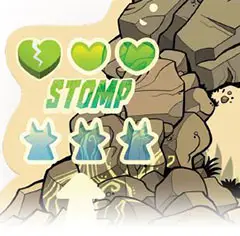
When a hero unit deals a wound to the guardian, place one wound token on an empty wound space of the targeted guardian location.
If all of the wound spaces on that guardian location are now full, the ability associated with that guardian location is disabled and cannot be used by the guardian player.
If all wound spaces on the entire guardian board (i.e., on all guardian locations) are now full, the guardian has been eliminated and the hero player wins instantly.
Hero Abilities
Many of the hero units have abilities that allow them to make special maneuvers as they battle the guardian.
-

Mount
When a hero unit with the MOUNT ability enters the guardian's ground space, they may immediately take one free LEAP action.
-
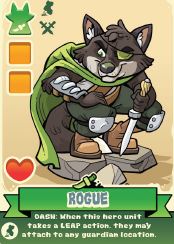
Dash
When a hero unit with the DASH ability takes a LEAP action, they may attach to any guardian location, not just a connected one. This can be done when leaping from the guardian's ground space or from another location on the guardian.
-
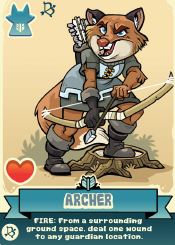
Fire
When a hero unit with the FIRE ability is in a surrounding ground space, they may take a MISSILE ATTACK action to deal one wound to any location on the guardian.
-
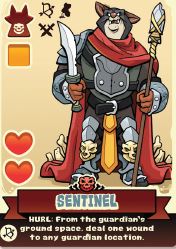
Hurl
When a hero unit with the HURL ability is in the guardian's ground space, they may take a MISSILE ATTACK action to deal one wound to any location on the guardian.
-
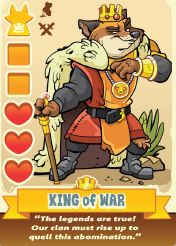
No Ability
Instead of an ability, the King of War has the most power and health, making it easier to learn how to play.
-
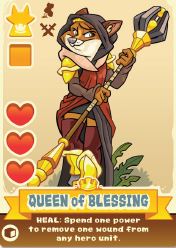
Heal
A hero unit with the HEAL ability may spend one power to remove one wound token from any hero unit in play. This includes hero units in ground spaces and attached to locations on the guardian.
-
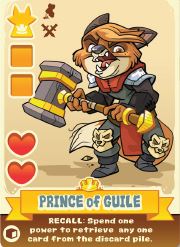
Recall
A hero unit with the RECALL ability may spend one power to allow the hero player to examine the contents of their discard pile, choose one card, and return it to their hand.
-
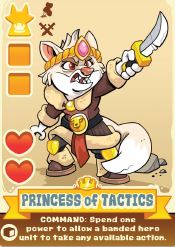
Command
A hero unit with the COMMAND ability may spend one power to allow a banded hero unit (i.e., a hero unit in the same ground space or attached to the same guardian location) to move or take any available action.
End of the Game
The game ends immediately when one player fulfills one of their win conditions!
The hero player wins by eliminating the guardian. The guardian is eliminated as soon as all wound spaces on the guardian board are filled with wound tokens.
The guardian player wins by eliminating the leader -OR- fulfilling the unique win condition of their selected guardian. The leader is eliminated as soon as all wound spaces on the leader's unit card are filled with wound tokens.
Player Handicaps
Beginner players may find they are at a bit of a disadvantage against experienced players. To counteract this, you may give the less experienced player up to six ancient relic tokens during setup.
Each ancient relic token can be spent during the game to allow the player to take an additional action during their turn. Once spent, ancient relic tokens are removed from the game.
Continue Reading
